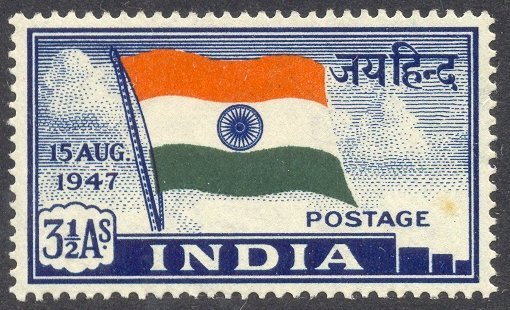National Flag – Jai Hind

Technical Data
| Stamp Set | Independence |
|---|---|
| Date of Issue | November 21, 1947 |
| Denomination | 3.50 ANNAS |
| Quantity | 2,300,000 |
| Perforation | comb 13½ x 14 |
| Printer | Nasik Security Press |
| Watermark | Star of India Multiple [Up] |
| Colors | Multicolor |
| Catalog Codes |
Michel IN 184 Stamp Number IN 201 Yvert et Tellier IN 2 Stanley Gibbons IN 302 |
| Themes | Flags | Special Occasions |
The postal system in India holds a venerable place in its history, reminiscent of the grandeur of its ancient temples. Its origins lie in the imperative need for communication, ensuring that the emperor remained connected with officials overseeing distant provinces while staying abreast of developments across the realm. Ibn Battuta, a traveler in India during the fourteenth century under Mohamed Bin Tughlak’s reign, provided insights into this system, highlighting the presence of two types of couriers: horse and foot.
These couriers played a pivotal role in facilitating swift communication throughout the vast expanse of the Indian subcontinent. Foot couriers were stationed at intervals of every mile, while horse couriers, often integral to the sultan’s cavalry, were strategically placed every four miles. Each courier carried dispatches along with a whip adorned with small bells, signaling their arrival and expediting the transfer of messages.
The Indian postal service officially opened its doors to the public in 1837, with postage charges collected in cash. To facilitate payments, copper tokens were introduced, with the lowest rate set at Two Annas for every hundred miles. The introduction of postage stamps followed suit, commencing in Sindh in 1852, marking a significant milestone in the evolution of India’s postal infrastructure.
In a momentous leap forward, India witnessed its inaugural official Air Mail flight in 1911. French aviator M. Pequet undertook this historic journey, transporting 6,500 letters and postcards from the U.P. Industrial and Agricultural Exhibition Grounds in Allahabad to Naini Junction. This groundbreaking event, commemorated with a souvenir postmark, heralded the integration of air transportation into India’s postal network, promising expedited and efficient mail delivery services across the nation.
